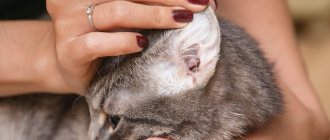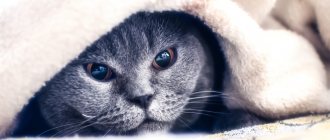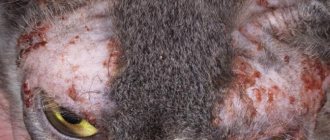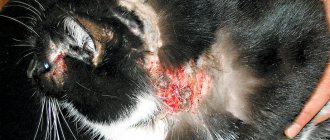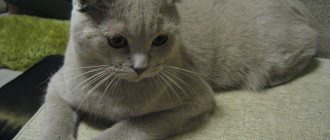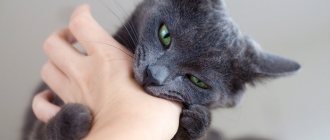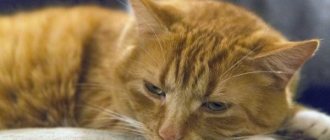Review of root causes
Before taking your pet to the veterinarian, you should make sure that the ulcer on the nose is not the result of an injury received in a fight or after a fall. If this point cannot be clarified (the owner was not present at the time of injury), then you need to keep in mind the following options associated with this symptom:
Eosinophilic granuloma. Mainly affects the oral mucosa, tongue, palate and lips. But it can also manifest itself as an ulcer on the nose, which practically does not bother the cat due to the lack of itching. Over the course of the process, its size may not change, but there is a risk of complications due to secondary infection. To confirm the diagnosis, a cytological examination of the fluid taken from the wound is performed. For small lesions, first try changing the brand of food, removing the plastic bowl and toys (if any). It is recommended to change the bowl to ceramics or glass. In most cases, this is enough, the ulcer heals within 1-2 weeks. If multiple lesions are present or the ulcer does not heal for a long time, then prednisolone can be used under the strict supervision of a doctor. But you need to understand that suppressing symptoms does not guarantee complete recovery. To do this, it is necessary to look for and exclude a possible cause (diet, flea dermatitis).
Wound. It can also cause ulcers on the nose of a cat at any age. Most often, such injuries occur after participating in fights with other animals. Deep scratches or abrasions become covered with a crust that itches. And if the pet constantly rips it off, then an ulcer forms at the site of the wound. Scratches and abrasions can be treated with an antiseptic solution (moisten a cotton swab with chlorhexidine and wipe thoroughly). If the sore is not complicated by a secondary infection, then complete healing occurs within 2-5 days.- Contact dermatitis. This is a common phenomenon among cats who like to stick their noses everywhere. Chemicals, detergents, and medications can act as irritating factors. A severe reaction may cause a large pink sore to appear on the nose. After such incidents, the animal is advised to take antihistamines. It is also necessary to prevent your pet from having access to potentially dangerous substances (powders, personal hygiene products, etc.).
Burn. It can also cause a red sore on a cat's nose. Most often found in kittens who are just exploring this world. Your pet can get burned on hot dishes or even food. In most cases, burns heal well and quickly. The wound becomes covered with a crust, which falls off on its own after 2-4 days. It is important to prevent the animal from tearing off the crust with its claws. Outdoor cats are more likely to experience frostbite, which is also accompanied by the appearance of sores on the face and limbs.- Parasites. Less common than the above circumstances, but can also cause the appearance of ulcers on a cat’s nose. Most often, this phenomenon can be caused by an allergic reaction to flea saliva. Therefore, to exclude this option, it is mandatory to treat the animal against fleas (Stronghold and Frontline are considered the most effective drugs today). Then worming is carried out (Drontal and Milbemax are considered the best today). And if after 3-4 weeks the symptoms persist, then the option of parasites is excluded.
- Neoplasms. Benign formations are more common in young animals, malignant ones are usually diagnosed after the age of 10 years. Benign neoplasms include papillomas that appear in different parts of the body. If they appear on the nose, then there is a risk that the pet may rip them off accidentally (during play or a fight) or on purpose (if they cause discomfort). In their place, an ulcer will form that will not heal for a long time. Therefore, papillomas located on the nose, eyelids, and lips are recommended to be removed. This is done using cryosurgery or laser.
In animals over the age of 10 years, when a nasal ulcer appears, the option of squamous cell carcinoma and carcinoma should be considered, to confirm which a puncture is taken from the lesion and sent for histological examination. Considering the location, treatment can only be medicinal. The prognosis at any stage of tumor detection is always cautious.
The crusts on your cat's nose may be brownish or black. This symptom is characteristic of a fungal infection, an inflammatory process in the nasopharynx, or an allergic reaction. The most harmless cause of crust formation is considered to be household injuries.
The fact is that a healthy cat's nose is slightly moist. This prevents the normal restoration of damaged skin, so wounds can take a long time to heal. If the owner is absolutely sure of the nature of the crusts, it is necessary to help the pet’s body recover as quickly as possible. To do this, it is recommended to treat your nose with an antiseptic several times a day. Preventing re-infection of the wound significantly accelerates regeneration and the crusts begin to disappear a few days after the start of treatment.
A dark crust on the nose, which is accompanied by discomfort and is a consequence of skin damage, should not be a cause for concern. In this case, no treatment is required; the crust will fall off on its own when the tissues are completely restored.
Treatment with an antiseptic is only necessary if weeping erosions or crusts appear at the site of the wound, blocking the respiratory tract.
Calcivirosis
If a black crust suddenly appears on your cat’s nose, you should take a close look at the animal’s behavior. One of the dangerous cat diseases is calcivirosis. Animals are usually vaccinated against this disease, but street cats that accidentally enter the house may not be vaccinated. Symptoms of calcivirosis:
- wounds and crusts on the mucous membranes of the mouth, ears and nose;
- conjunctivitis and tearing eyes;
- damage to the paw joints;
- increased body temperature;
- swollen lymph nodes;
- labored breathing.
To treat calcivirosis, you should consult your doctor about the use of medications. There is no universal treatment regimen for this disease; therapy is selected depending on the symptoms and age of the pet.
Crusts on the nose should be lubricated with chlorhexidine or Lugol's solution twice a day. To make breathing easier, the nasal passages must be treated with special drops.
If a cat has an ulcer on the nose, this may be a sign of pathologies such as infection with pathogenic microflora, an allergic reaction, polyps, or traumatic injuries. In addition to wounds, the condition may be accompanied by fever, sneezing, coughing, and changes in the animal’s behavior. At the first symptoms, it is recommended to take your pet to a veterinarian, who will prescribe medications or perform surgery.
Dermatological diseases
Crusts on a cat’s nose can be the result of skin pathologies and dermatitis. These diseases are caused by fungi and bacteria. To accurately determine the cause of the formation of crusts, it is necessary to undergo a series of tests, including a nasal microflora smear and skin scraping from the affected area. The doctor will also illuminate the animal with a special lamp, which allows you to quickly determine the presence of fungal infections.
Treatment depends on the type of disease. For fungal infections of the epidermis, antimycotic drugs are used. Treatment is carried out using ointments and solutions for treating the nose. In case of a bacterial infection, the crusts should be treated with antibacterial drugs, for example, Levomekol ointment.
For dermatological diseases, antiseptic treatment of the affected area is mandatory. This is necessary to prevent secondary infection. For this purpose, a solution of chlorhexidine or miramistin is used.
Why do wounds occur?
Most often, the formation of ulcers and crusts on the nose is promoted by ailments, such as:
Calicivirus
When an animal is infected with such a virus, it may develop conjunctivitis.
It is caused by the Feline calicivirus virus. Infection occurs through contact with a sick animal through saliva, nasal moisture, tears, or when a healthy animal uses bowls and a tray of an infected animal. A cat can also inhale the virus. Manifestation:
- the appearance of wounds on the mucous membranes of the nose and mouth;
- refusal to eat;
- temperature increase;
- dyspnea;
- conjunctivitis;
- lameness due to inflammation of the joints.
Fungal infections
The causative agents are the fungi cryptococcosis, actinomycosis, and Candida. Routes of infection include contact with a sick animal, long-term use of antibiotics, and decreased immunity. Cats that come into contact with soil and birds can also become infected. The fungus can affect not only mucous membranes, but also appear on the pads of the paws, between the toes, and spread to the stomach and genitals. Symptoms:
- bloody discharge from the nose that forms crusts;
- cough, sneezing;
- temperature increase;
- the appearance of a whitish coating or scales on the respiratory system or in the mouth;
- general deterioration of condition.
Bordetellosis
This disease is characterized by the appearance of a cough in the pet.
The disease is caused by Bordetella bacteria, and the disease itself can be transmitted from animals to humans. Cats get sick through contact with saliva, moisture from the nose, sneezing of a bacteria carrier, and also by eating food from the bowl of a sick animal. Signs:
- discharge from the eyes and nose, at the site of which cracks and sores appear;
- decreased appetite;
- hyperemia;
- difficulty breathing;
- cough;
- enlarged lymph nodes.
Allergic reaction
It occurs as a response of the cat’s immune system to an allergen. These include cleaning products, indoor mold, dust, and medications. The cause of an allergic reaction can be food additives if the owner treats the pet with smoked or canned foods that are not intended for animals. Symptoms:
- crack or wound on the lips, nose, bald patches near the ears;
- redness of the ears and skin;
- hair loss, bald patches;
- severe itching of the affected areas;
- worry and anxiety.
Polypous formations
The presence of such formations in the nose forces the animal to shake its head frequently.
They are benign pedunculated growths that form on the nasal mucosa. They occur mainly against the background of chronic diseases of the nasopharynx - otitis media, rhinitis or due to impaired tissue development. Polyps can spread to the structures of the middle ear. Due to impaired nasal breathing, the cat rubs its nose, which causes a sore. In addition, the following signs indicate polyps:
- sniffling and wheezing;
- difficulty swallowing and breathing;
- change in voice timbre;
- frequent shaking of the head;
- impaired coordination of movements if the polyp has grown into the ear;
- weight loss due to difficulty eating because the nose is not breathing.
Bruises and wounds
Violation of the integrity of the nasal covering occurs as a result of a cat falling from a height, an accidental blow to a heavy object, or after a fight with relatives. Injuries provoke nosebleeds, so the damaged area becomes covered with a crust. The condition is manifested by the animal's restlessness, temporary aggression due to pain, snorting, and sneezing. However, bruises and wounds can be combined with serious head injuries. Therefore, you should consult a doctor if your cat develops the following symptoms:
The animal should be taken to the veterinarian if the injury is combined with a convulsive syndrome.
- impaired coordination of movements;
- vomit;
- nosebleeds that won't stop;
- convulsions;
- loss of consciousness.
Non-communicable causes
There are the following types of non-infectious diseases in which crusts form on the nose:
- allergic conditions;
- injuries;
- violation of conditions of detention.
Allergic conditions
All allergens that cause a runny nose lead to the release of exudate, which dries out and crusts form. The nasal mirror is injured by hard scabs, ichor is released, secondary microflora is added and the pet’s condition worsens.
The development of a hypersensitive reaction is influenced by the following unfavorable factors:
- increased sensitivity to feed mixture ingredients;
- response to pollen from flowering plants;
- irritating effects of perfume odors, tobacco smoke, household chemicals;
- irritating effects of toys, tray filler, bedding made of synthetic materials;
- reaction to human hair or the fur of other pets;
- side effects of medications.
Treatment consists of eliminating the causes. Caused an inappropriate reaction. They stop taking medications that can cause an allergic response and switch to ready-made hypoallergenic food.
Remove objects that emit odors from the room and stop smoking in the presence of the pet. Change the tray filler and bedding. In some situations, the use of antihistamines is required.
Injuries
Such crusts heal on their own
. Crusts are formed if a cat scratches its nose in a fight or through contact with sharp or prickly objects. When you hit the nose, slight bleeding may occur; the released liquid dries, forming crusts. If there is no suppuration under the scabs, observe the healing process of skin defects. Otherwise, use an antiseptic wound-healing ointment.
Be sure to read:
What to do if pus comes out of your cat’s nose, what could it be, should you be afraid?
Violation of containment conditions.
When the central heating is turned on in winter or during hot weather, the air dries out and the skin on the cat's nose cracks. The ichor is released, which dries and forms crusts. If in hot weather the cat is exposed to a stream of cold air from an air conditioner, hypothermia develops and rhinitis occurs, in which snot is released from the nose. They dry out and form crusts.
Frequent bathing in combination with drafts in the apartment also leads to hypothermia and rhinitis. Treatment consists of introducing immunomodulatory or antimicrobial drops into the nasal cavity.
How to treat ulcers on the nose?
Surgical intervention
Surgery is required for polypous growths. A ventral Bull osteotomy is performed, in which the lower part of the middle ear bone is excised and the polyp is removed. The polyp is also pulled out, causing it to tear away from the stalk. However, this method is dangerous for the development of relapses.
Drug therapy
Liniments should be applied to the nose while the cat is sleeping, otherwise she will lick the medicine, which will cause bowel upset.
All medications are prescribed by a veterinarian; self-medication is unacceptable. Minor scratches on the nose heal on their own. If suppuration occurs, it is recommended to lubricate the organ with Levomekol liniment. It is recommended to treat the crusts with a decoction of chamomile, calendula, and oak bark. For infectious diseases, depending on the etiology, the drugs shown in the table are prescribed:
| Drug group | Medication |
| Antibiotics | "Enroxil" |
| "Clavaseptin" | |
| Bayer Baytril | |
| "Zoetis Synulox" | |
| "Veraflox" | |
| Antifungal | "Ketoconazole" |
| "Clotrimazole" | |
| Potassium iodide | |
| Saline solutions | Sodium chloride |
| "Ringera" | |
| Glucose | |
| Immunostimulants | Any vitamin and mineral complexes for cats |
| "Gamavit" | |
| Antibacterial lotions for treating sores on the nose | "Divopride" |
Types of sores on a cat's nose
Formations on a cat's nose can be very different. There are quite a lot of them. The most common among them are:
- ulcers and erosions;
- black dots;
- dark spots;
- different types of crust;
- scabs;
- purulent formations;
- swelling;
- cyst;
- bumps and growths.
All these manifestations, regardless of the nature of their formation, indicate certain changes in the animal’s body, and not for the better. Most often these are signs of acute or chronic and indolent diseases of various types.
Note! The only exception, perhaps, is age spots, which appear due to special pigments in the skin and skin responsible for their color. They can be acquired by an animal from birth and not be dangerous to its health.
There is no need to panic about age spots
Tip 1: Causes of crusts on the nose of cats
Why a cat sneezes can only be understood by carefully observing its appearance, well-being and behavior. The reason may simply be dust under the cabinet that accidentally got into the pet’s respiratory tract. But if sneezing is repeated, this may be one of the symptoms of an incipient disease. First, it is necessary to exclude the presence of parasites, which in some cases is accompanied by sneezing. Therefore, it is advisable for the owner to urgently give his pet anti-helminth medications. They are sold in every veterinary pharmacy specifically for cats and are used depending on the weight of the animal. They are mixed with a small amount of food and given to the pet. At the same time, all family members must also take antihelminthic drugs for people. After this procedure, cats should put special drops between their shoulder blades against fleas. Flea secretions can cause allergies, including sneezing. If, after introducing a new food or immediately after purchasing a chair, your pet begins to sneeze frequently, but no other symptoms are observed, this may be a consequence of an allergy. It is advisable to analyze what has happened new in the cat’s life in the last week, and when exactly he began to show alarming signs. Sometimes it is enough to simply exclude the allergen. If these measures have not helped at all, and the cat continues to sneeze, there is no need to try to find answers on veterinary forums. After all, from such advice “blindly” you can lose precious time necessary for effective treatment of the animal. The rule of harm of self-medication also applies here. The danger can threaten not only the pet itself, but also other pets, and even the owners themselves. For example, feline toxoplasmosis, as well as chlamydia, are a serious threat of miscarriage in pregnant women. Sometimes sneezing in cats is accompanied by lacrimation and runny discharge from the nose. At the same time, the animal’s appetite worsens and lethargy appears. Such signs may be present both with the feline herpes virus and with many diseases of the upper respiratory tract caused by fungi, bacteria and viruses: toxoplasmosis, chlamydia, bordetellosis, rhinotracheitis, calicivirus, etc. If, after curing the parasites and eliminating the possibility of allergies in the animal, The cat's sneezing continues, you should contact your veterinarian so that he can correctly diagnose the animal and prescribe effective treatment. Next, the task of pet owners is to carry out all the necessary procedures on time, be it nasal drops, injections or medicine in tablets. So, you should carefully observe all personal hygiene measures and limit the interaction of a sick animal with household members. And the owner serving the cat must wear a protective mask and gloves. In any case, the disease is easier to prevent than to treat. For this purpose, special vaccines are used. It is best to start vaccinating young kittens at six weeks of age. Until the age of fifteen weeks, babies are given several vaccinations at intervals of 3–7 weeks: against leukemia, rabies, cat flu and panleukopenia. Also, do not forget about good animal nutrition and hygiene.
Photos of cats with crusts on their noses
Infectious diseases
A contagious disease of the upper respiratory tract is calcivirosis. This formidable pathology affects only representatives of the cat family; the virus can lead to the most disastrous consequences - the death of the animal. Pathogenic microorganisms spread throughout the external and internal organs of the pet, filling the eyes, nose, mouth, throat, and lungs. Black crusts on a cat's nose may indicate the penetration of a dangerous infection into the body. In addition to the above sign, the following symptoms can be traced:
- visually visible sores on the tongue, gums;
- nasal discharge (snot);
- ulcers on the mucous membranes with liquid contents;
- profuse salivation and lacrimation;
- apathy towards the environment, lethargy;
- fever;
- lack of appetite;
- swollen lymph nodes;
- pain in the joints, and, as a result, limping.
There may not be all the signs, but black crusts near the nasal passage, as well as sores in the mouth, are a sure sign of a dangerous disease. If you discover such a problem, you should immediately go to the doctor.
Treatment of a contagious disease can occur both in a hospital and at home. The main thing is to protect the patient from other pets. As therapy, Lugol's solution is prescribed, which is used to smear scabs and sores. The rest of the treatment measures are based on the principle of adherence to a healthy life regimen.
What can cause skin lesions in cats?
Skin lesions in cats have different origins. Among the most common reasons for their appearance are:
Flea dermatitis
- Ectoparasites. Parasites that live on the surface of the body of pets (fleas, ticks) are the causative agents of dermatitis, sarcoptic mange, notoedrosis, otodectosis;
- Fungi that cause lichen.
- Improper care or change in the animal’s diet, as a result of which the cat develops allergies, acne, and eczema.
- Improper development of sebaceous glands and hair follicles, leading to acne.
- An allergic reaction, stress, skin injuries, kidney diseases, tumors, diabetes mellitus, which can become a prerequisite for bacterial infections to damage the pet’s skin.
- Mental disorders that can lead to alopecia.
- Pathologies of internal organs, against which eczema can develop.
Skin diseases: causes, symptoms, treatment and prevention
There are so many skin diseases that affect cats that it is simply impossible to present all the available data about them in one article. However, there is a group of dermatological diseases that are most often diagnosed in these pets. It includes infections caused by various bacteria and fungi, pathologies caused by mites (demodex, otodectosis), lichen, psoriasis, acne, bedsores, allergies, bumps and other formations on the skin.
Bacterial infection
The most common cause of bacterial infections in felines is staph. This type of skin disease in pets can be recognized by a number of symptoms. Manifestations of the disease and its treatment depend on the form of the pathology. Information about how infections of bacterial origin occur in these animals and how they are treated is presented in the table:
Dry form of bacterial infection
| Forms of bacterial infection | Symptoms | Treatment methods |
| Dry | Dense formations and crusts on the skin. | To eliminate signs of infection, depending on the clinical picture, the four-legged patient is prescribed oral antibacterial drugs (Amoxiclav, Cefoxitin, Clindamycin, Cephalexin) and topical agents (Miramistin, Levomekol, zinc ointment). Also, medicated shampoos (Api-San, Elite) are indicated for a sick pet. |
| Wet | Hyperemia and moisture in the affected areas of the epidermis, accompanied by rashes, the formation of ulcers and weeping crusts, and itching. |
Fungal infections and different types of lichen
This type of skin disease, also known as “lichen,” is caused by fungi; less commonly, it occurs due to viruses, a nervous breakdown, hormonal imbalance, or allergies. Most often, the epidermis is affected by fungal infections Trichophyton Microsporum canis and Microsporum gypseum. If treatment is started in a timely manner, the animal can be cured in 21 days. If the deeper layers of the skin are affected, complete recovery may take up to 6 months. Information about the types of lichen (their photographs are posted below) in cats is presented in the table:
Ringworm
| Types of lichen in cats | Symptoms | Treatment |
| Shearer |
|
|
| Pityriasis (multi-colored) |
| |
| Pink (not fungal etiology) |
|
|
| Weeping (eczema, caused by hormonal imbalance, stress, etc.) |
|
|
Ear mite
Fungi can also infect the outside of your pet's ear. Most often, otomycosis is caused by Aspergillus or Candida. This disease is accompanied by severe itching, redness, slight discharge of purulent exudate, and greenish-gray or pure gray deposits.
When is it necessary to consult a veterinarian?
In most cases, dermatological diseases in cats are treated at home and do not pose a threat to life. However, there are situations in which mandatory veterinary assistance is required. Sometimes self-treatment of a pet can lead to serious and even tragic consequences. Reasons for visiting a veterinary clinic should be:
- increase in pet's body temperature;
- decreased motor activity and lack of response to external stimuli for a long time (more than 24 hours);
- refusal of food and water;
- inability to rise independently;
- bleeding;
- uncontrollable vomiting;
- diarrhea;
- suppuration in the eye area;
- impaired respiratory function (urgent treatment measures are required if the pet is breathing heavily and wheezing or if its breathing is rapid and shallow);
- blood in urine or stool;
- a plaintive meow for no apparent reason.
Infectious diseases
Nasal discharge that hardens in the form of crusts can be a sign of a variety of diseases, including calicivirus, viral rhinotracheitis, and reovirus infection. Pay attention to the cat’s behavior - has he become lethargic, depressed, or has his appetite deteriorated? A common cause of crusts on the nose is calicivirus infection (calicivirus). In this case, ulcers also appear in the oral cavity.
If a cat often sneezes, rubs its face with its paws, or snores in its sleep, this may indicate that the animal is sick. Other signs of infection include fever, drooling, coughing, and green or yellow purulent discharge from the eyes.
Treatment for infectious diseases in cats is prescribed by a doctor. The sooner symptoms of a disease are detected in a cat, the sooner you need to contact a veterinarian - many diseases, especially kittens, old and weakened animals, develop very quickly, leading to death in the absence of adequate treatment.

